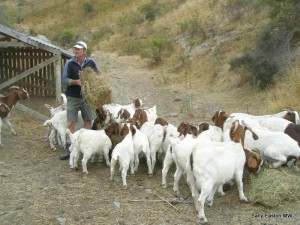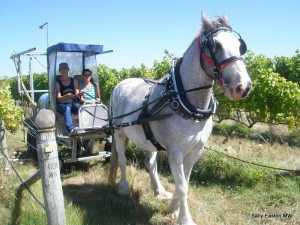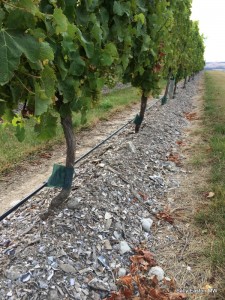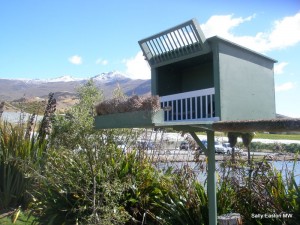New Zealand shows the specificity of sustainability

Looking after the goats at Felton Road
A version of this article was first published in the August 2014 issue of Drinks Business magazine.
New Zealand may be ahead of the sustainability game with almost all producers signed up to some sort of sustainability accreditation system, whether the country’s own Sustainable Winegrowing New Zealand (SWNZ), or certified organics, biodynamics or ISO 14001, but the situation on the ground is far from a one-size-fits-all model. Anyone hoping for a single index that measures producers’ paths towards increasing sustainability is sadly disillusioned.
The country’s activities towards sustainability goals illustrate well that a mix of national and regional issues exist. It is only by taking an individual look at principles and practices that producers are able to continue to make progress towards greater sustainability. This inevitably involves trade-offs that influence philosophical and commercial decisions.
Reduction of agrochemical use is an obvious national ambition. NZ Winegrowers’ general manager for sustainability Philip Manson said “there has been an evolution and we’re getting better at spray practices from ten years ago.” For example the standard strategy against light brown apple moth (LBAM) was organophosphates. Research was undertaken which showed “you got better control by removing organophosphates and by plantings to encourage parasitoids and other beneficials.” Sally Williams, winemaker at Wither Hills said “we plant buckwheat every ten rows. It has completely eradicated the need for pesticide against LBAM.” Buckwheat, which attracts wasps that parasitise LBAM, is widely used by growers.
This stance of doing the science, offering an alternative to chemicals, then doing the education, is enabling the NZ industry to change people’s behaviour. For leafroll virus, high on the agenda as a national issue, the science is still being done, but the commercial imperative is clear – once 20% of a vineyard is infected with leafroll virus, the whole vineyard needs to be pulled up.
Other issues are more regionally focused. It may be possible to measure irrigation water, but it doesn’t necessarily help. Vineyards may be commonly dry-farmed in Gisborne, but that may be because annual rainfall is around 900mm, plus the region’s clay soils have higher water holding capacity. In Central Otago where annual rainfall can be mid-300s mm, irrigation is almost essential.
Hawkes Bay has nearly as much precipitation as Gisborne, but the Gimblett Gravels have free-draining soils. Irrigation is often needed here, but the levels of rainfall also create mould pressure through the Bay, as they do in Gisborne. So areas performing well on low irrigation water use, are more likely to perform less well on measures of pest and disease management. It’s probably no coincidence that James Millton, of Millton Vineyards, ploughs a fairly lonely biodynamic furrow in Gisborne.

Applying biodynamic prep above the vines at Seresin
Much of Marlborough also has free-draining soils, but it’s also sunny and dry with rainfall in the region of 600mm. There may be less disease pressure, but more than half of the region’s vineyards are irrigated. Additionally, the region has a notable frost risk that other regions do not. A regular equation to solve is the financial and environmental expense of a frost fan versus that of helicopters. On the other hand said Anna Flowerday of Te Whare Ra “Marlborough’s climate is favourable for organics”, which ‘scores’ well on other sustainability parameters.
Nationally, NZ appears not to have a shortage of water. The emphasis has become “using water smarter” said Jason Flowerday also of Te Whare Ra. “Drip irrigation used frequently with low volumes of water encourages roots to sit close to the surface. As we want roots to go down, we still use drip irrigation but we emulate a rain event. We put a larger amount of water for a longer time. The water goes down and the roots have to follow.” Marlborough producers might use anywhere from around 3 to 8 litres of water per vine per day during the growing season, according to cultivar and soil water-holding capacity.
Complicating the water picture further has been the evolution from bare earth common in the late 1990s to the widespread use of cover cropping. The benefits evidently outweigh the holistic costs of water use, though it too, comes with regional variations.
Inter-row cover-cropping has been great to bio-control LBAM. However, in frost-prone Marlborough, Flowerday prefers to plough in his cover crop as a green manure in spring, creating around three weeks of bare soil, which is warmer than grass, during the most frost-risk season.
Undervine covercropping is possible more challenging. It is also more likely to be practised on organic vineyards, where herbicides are being eliminated. Mike Insley, national viticulture manager at Brancott Estate said “we use 30-40% more water on our organic blocks. The cover under the vine competes directly with shallow feeder roots and puts a lot of stress on the vines.”
Over the Richmond Ranges to the west in Nelson, Julian Coakley, the vineyard manager at Woollaston Estates also found “with an undervine cover, water use went up 50%”. But this has been a benefit, given Nelson’s around 1,000mm rainfall. He said “we see less grape splitting. The growth undervine sucks up the immediate moisture, reducing the amount that gets to the vine.” And despite being cooler than Marlborough, Nelson does not have the frost risk of Marlborough.
For Neudorf’s Tim Finn this undervine competition is also a good thing. It has stopped vines’ feeder roots staying near the surface. His vine roots under the grass now go down around 80cm, which he said allows him to be more expressive of terroir. Added to which he’s eliminated the two to three sprays a year of glyphosate he previously applied when he kept the undervine surface clear.

Undervine composting at Yealands
But undervine cover doesn’t work for Siefried’s, also in Nelson. Leaf plucking keeps the canopy open, and they also knock down the undervine cover with sprays twice a year, to avoid the humidity the crop generates, and along with it, the threat of botrytis. In winter, sheep keep the cover trim.
Such risk of elevated humidity is classically antagonistic to organics and biodynamics. It is Central Otago where botrytis and mildews are generally not regarded as overriding regional issues, which is one factor allowing organics and biodynamic cultivation to thrive. Modest precipitation levels, some 300 and 600mm depending on sub-region, avoid the moist conditions typically preferred by these diseases.
But the region needs irrigation to compensate for the modest rainfall. A fragile soil structure with often very little organic matter, so no means to retain moisture, adds to the need for irrigation. Partly for this reason undervine cover is more difficult. Gareth King, the viticulturist at Felton Road said undervine cover “is too much competition for the vine.”
Building soil organic matter is a strong driver in Otago. With composting and irrigating at night King now irrigates on average less than one litre per vine per day.
Composting is not restricted to Central Otago. The 900-hectare vineyard at Yealands Estate in Marlborough takes in around two-thirds of all of Marlborough’s grape marc, around 40,000 tonnes of it. Two people are employed full time to work on composting where marc is mixed with mussel shell, kelp, bark and lime. Jeff Fyfe, their senior winemaker and winery manager said “it has reduced our water use and our use of fertilisers. And the soil now has worms!” Using grape marc on site appears to be a sustainability no-brainer. Williams added “we use all the marc on site. It cost us NZ$30,000 to get grape marc removed from site. Now we spend $5 to 10,000 to spread it between the rows.”
Sheep were always a larger than life feature of the New Zealand landscape, and they are increasingly becoming an integral part of the vineyard landscape. They ‘mow’ winter cover crops, add natural fertiliser, and perform a pre-veraison leaf-plucking operation. But, said Kate Radburnd of Pask, “they are a lot of work and they can do damage. We try to use more sheep because it’s the right thing to do, but where timing is critical, we will use a machine.”

Falcon box at Peregrine
Such a pragmatic approach allows growers to work towards greater sustainability, without fearing for their fruit. This is one of the advantages of such a system, but it does require producers to want to do the right thing. The country’s newly launched Wine Industry Sustainability Engine (WiSE) is designed to better enable producers to compare their own sustainability performance against others from the same region. This may offer the localised motivation needed to encourage producers to make their next steps on the sustainability journey.
My visit to New Zealand was sponsored by New Zealand wine.



